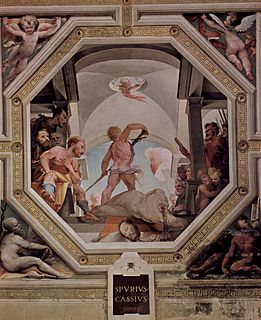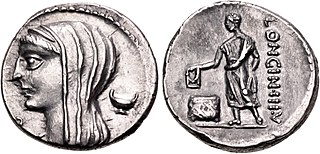Related Research Articles
Lucius Cassius Dio or Dio Cassius was a Roman statesman and historian of Greek and Roman origin. He published 80 volumes of the history on ancient Rome, beginning with the arrival of Aeneas in Italy. The volumes documented the subsequent founding of Rome, the formation of the Republic, and the creation of the Empire, up until 229 AD. Written in Ancient Greek over 22 years, Dio's work covers approximately 1,000 years of history. Many of his 80 books have survived intact, or as fragments, providing modern scholars with a detailed perspective on Roman history.

Spurius Cassius Viscellinus or Vecellinus was one of the most distinguished men of the early Roman Republic. He was three times consul, and celebrated two triumphs. He was the first magister equitum, and the author of the first agrarian law. The year following his last consulship, he was accused of aiming at regal power, and was put to death by the patricians.
Manius Acilius Glabrio was a Roman statesman and general, grandson of the jurist Publius Mucius Scaevola.

The gens Julia was one of the most ancient patrician families in ancient Rome. Members of the gens attained the highest dignities of the state in the earliest times of the Republic. The first of the family to obtain the consulship was Gaius Julius Iulus in 489 BC. The gens is perhaps best known, however, for Gaius Julius Caesar, the dictator and grand uncle of the emperor Augustus, through whom the name was passed to the so-called Julio-Claudian dynasty of the first century AD. The nomen Julius became very common in imperial times, as the descendants of persons enrolled as citizens under the early emperors began to make their mark in history.

The gens Cassia was a Roman family of great antiquity. The earliest members of this gens appearing in history may have been patrician, but all those appearing in later times were plebeians. The first of the Cassii to obtain the consulship was Spurius Cassius Viscellinus, in 502 BC. He proposed the first agrarian law, for which he was charged with aspiring to make himself king, and put to death by the patrician nobility. The Cassii were amongst the most prominent families of the later Republic, and they frequently held high office, lasting well into imperial times. Among their namesakes are the Via Cassia, the road to Arretium, and the village of Cassianum Hirpinum, originally an estate belonging to one of this family in the country of the Hirpini.
Cassius Longinus may refer to:
The gens Scribonia was a plebeian family at ancient Rome. Members of this gens first appear in history at the time of the Second Punic War, but the first of the Scribonii to obtain the consulship was Gaius Scribonius Curio in 76 BC.
Lucius Gellius Poplicola or Publicola was a Roman politician and general during the final years of the republic. He was consul in the year 36 BC, and was the grandson and adopted son of Lucius Gellius, who had been consul in 72 BC.
The gens Quinctilia, also written Quintilia, was a patrician family at ancient Rome, dating from the earliest period of Roman history, and continuing well into imperial times. Despite its great antiquity, the gens never attained much historical importance. The only member who obtained the consulship under the Republic was Sextus Quinctilius in 453 BC. The gens produced numerous praetors and other magistrates, but did not obtain the consulship again for over four hundred years.
The gens Aelia, occasionally written Ailia, was a plebeian family in Rome, which flourished from the fifth century BC until at least the third century AD, a period of nearly eight hundred years. The archaic spelling Ailia is found on coins, but must not be confused with Allia, which is a distinct gens. The first member of the family to obtain the consulship was Publius Aelius Paetus in 337 BC.
The gens Pinaria was one of the most ancient patrician families at Rome. According to tradition, the gens originated long before the founding of the city. The Pinarii are mentioned under the kings, and members of this gens attained the highest offices of the Roman state soon after the establishment of the Republic, beginning with Publius Pinarius Mamercinus Rufus, consul in 489 BC.
The gens Appuleia, occasionally written Apuleia, was a plebeian family at ancient Rome, which flourished from the fifth century BC into imperial times. The first of the gens to achieve importance was Lucius Appuleius, tribune of the plebs in 391 BC.
The gens Asinia was a plebeian family at ancient Rome, which rose to prominence during the first century BC. The first member of this gens mentioned in history is Herius Asinius, commander of the Marrucini during the Social War. The Asinii probably obtained Roman citizenship in the aftermath of this conflict, as they are mentioned at Rome within a generation, and Gaius Asinius Pollio obtained the consulship in 40 BC.

The gens Pomponia was a plebeian family at ancient Rome. Its members appear throughout the history of the Roman Republic, and into imperial times. The first of the gens to achieve prominence was Marcus Pomponius, tribune of the plebs in 449 BC; the first who obtained the consulship was Manius Pomponius Matho in 233 BC.
The gens Carisia was a Roman family during the latter half of the 1st century BC The most famous member of the gens was Titus Carisius, who defeated the Astures in Hispania, and took their chief town, Lancia, circa 25 BC; but in consequence of his cruelty and insolence, the Astures took up arms again in 22.
The gens Carteia was a Roman family towards the end of the Republic. It is best remembered for a single individual, Lucius Carteius, a friend of Gaius Cassius Longinus, who was with Cassius in Syria in 43 B.C.
The gens Cestia was a plebeian family at ancient Rome during the later Republic, and in imperial times. The first member of the gens to obtain the consulship was Gaius Cestius Gallus in AD 35. The family's name is commemorated on two monuments, the Pons Cestius and the Pyramid of Cestius which survive into modern times.
The gens Fabricia was a plebeian family of ancient Rome. Members of this gens are known from the early third century BC down to the end of the Republic, but they seldom attained positions of importance in the Roman state.
The gens Mescinia was a minor plebeian family at Rome. None of its members held any of the higher magistracies, but Lucius Mescinius Rufus, perhaps the most famous of the gens, was quaestor under Cicero during the latter's administration of Cilicia. Other Mescinii are known from inscriptions.

Aemilia, Licinia and Marcia were Roman vestal Virgins, who were prosecuted for having broken the vow of chastity in two famous trials between 115 and 113 BC. The first trial was conducted by the Pontifex Maximus Metellus Delmaticus, who sentenced to death Aemilia in 114 BC. The decision to spare the other two vestals nevertheless triggered outrage and a special court headed by Cassius Longinus Ravilla was created the following year to restart the investigations. Licinia and Marcia were subsequently put to death as well. The trials were heavily influenced by the political background and network of the participants.
References
- ↑ Joseph Hilarius Eckhel, Doctrina Numorum Veterum, v. 150.
- ↑ Lucius Annaeus Seneca, De Ira, iii. 18.
- ↑ Lucius Cassius Dio Cocceianus, Roman History, lix. 25 (as Betillinus Cassius).
![]() This article incorporates text from a publication now in the public domain : Smith, William, ed. (1870). Dictionary of Greek and Roman Biography and Mythology .Missing or empty
This article incorporates text from a publication now in the public domain : Smith, William, ed. (1870). Dictionary of Greek and Roman Biography and Mythology .Missing or empty |title= (help)